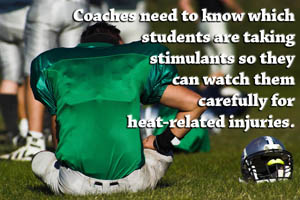One of the classes of drugs popular among teens is stimulants. While this class includes illicit stimulants like synthetic cannabis (referred to as Spice, K2 or many other nicknames), it can also include drugs prescribed for what doctors call attention problems. Drugs like Ritalin, Adderall, Concerta and Vyvanse are sought illicitly by some students who think it may give them an edge in their studies. Other teens or young adults who aren’t concerned about studies may want them for an increased ability to party into the night.
Ritalin and Concerta are similar chemically to cocaine and Adderall is combination of amphetamine and dextroamphetamine. Vyvanse is another form of amphetamine called lisdexemfetamine.
 While these drugs may be favorites of those seeking academic success or late night fun, they may also be sought by young athletes who think they may give them an edge during athletic competition. Dr. Sharon Orrange of the University of Southern California Medical Center points out that these stimulants provide greater acceleration, longer time to exhaustion and more strength during some tests of exertion.
While these drugs may be favorites of those seeking academic success or late night fun, they may also be sought by young athletes who think they may give them an edge during athletic competition. Dr. Sharon Orrange of the University of Southern California Medical Center points out that these stimulants provide greater acceleration, longer time to exhaustion and more strength during some tests of exertion.
But they also have the dangerous effect of clouding one’s perception of heat stress. In other words, a person may be suffering from increased stress from a hot day combined with their own exertion and not even be aware of it. A young person engaged in sports in a warm climate probably has no idea that he (or she) is increasing his risk of heat-related death by abusing these drugs. And when he is abusing them – that is, using them without a prescription – he is unlikely to notify his coach or other athletic staff of this risk factor.
The American Journal of Preventative Medicine noted that heat-related injuries among athletes increased 133% between 1997 and 2006. Football players are at the greatest risk. Between 1995 and 2014, 40 high school students and 8 college football players died from heatstroke suffered during practices or games.
Dr. Orrange further warns that athletic trainers and coaches need to know which students are taking drugs of this class so they can watch them carefully for heat-related injuries. But since students abusing these drugs are unlikely to admit it, how can the risk of heat-related injury be reduced?
Parents who learn about this risk need to talk to their kids about the effects of abusing these stimulants and the increased heat injury risk that accompanies their use. This is especially true of someone who is engaged in athletics over the summertime.
Even if your teen or young adult is not abusing these drugs, he might know someone who is and he should be encouraged to pass this warning along to others. By making this information known, it’s entirely possible that young lives could be saved.
Read more about the increased use of stimulants amongst young people.